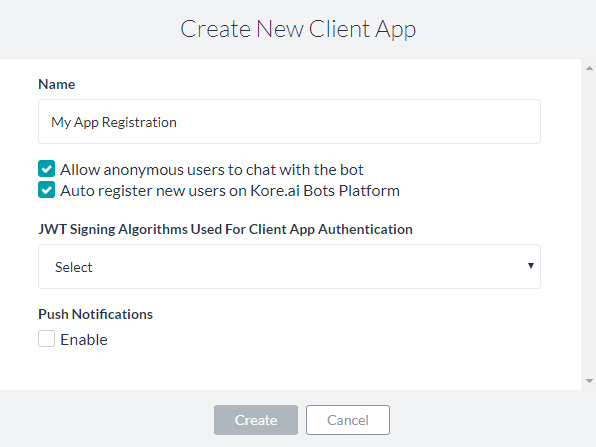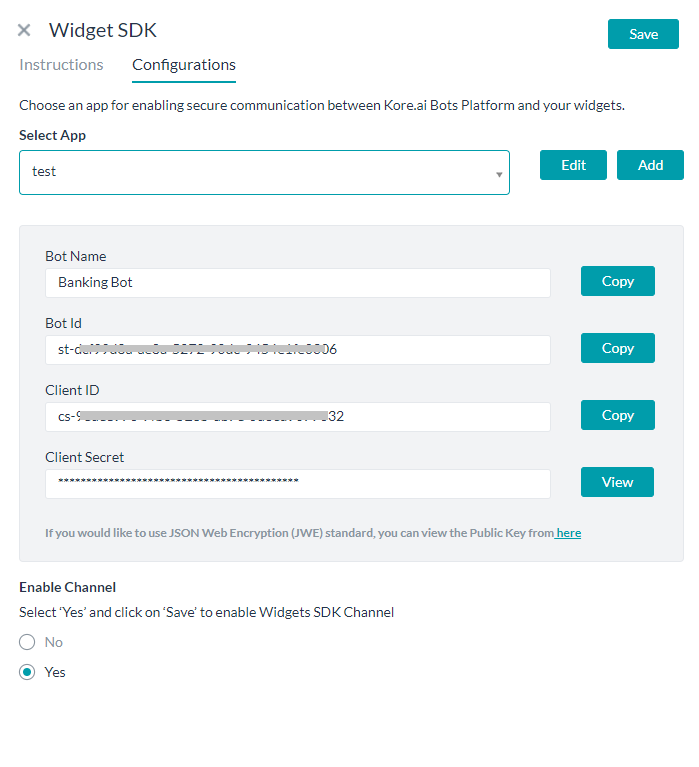Widgets SDK channel allows you to host widgets for presenting information from your bots and enabling interaction with your bots.
To add the Widget SDK Channel to your bot, you must first register, or create an app in Bot Builder. When you create an app, you are provisioning credentials for you application to communicate securely with Kore.ai servers. After you create an app, you can use that app registration in the configuration to add the Widget SDK Channel to your Bot.
To add the Widget SDK channel
- Open the bot to which you want to add the Widget SDK channel.
- On the bots menu, click Channel > Widget SDK.
- Navigate to Configurations tab.
- In the Select App drop-down list, select your existing app registration or click Create App to create a new app.

- In the Name field, enter the name for the app registration used in Bot Builder, for example, My App Registration.
- Select one of these scopes for the app:
- Allow anonymous users to chat with the bot: enables anonymous users to interact with the bot.
- Auto register new users on Kore.ai Bots Platform: Select to control the auto-user registration in Kore.ai if the user assertion is unknown.
- In the JWT Signing Algorithms Used For Client App Authentication drop-down list, select one of the following security algorithms:
- RS256: Select to enable the Public Key field. The Public Key is used by the Kore.ai Bots Platform to authenticate the client application.
- HS256: Select to generate a Secret Key and a Client ID. The Client ID is required for SDK initialization, and the Secret Key used by the Kore.ai Bots Platform to authenticate the client application.
- Optionally, In the Push Notifications section, click Enable and then specify a URL to send the notifications to.
- Click Create. The app registration details appear.

- To copy the app registration details to the clipboard for your application, you can click Copy for Bot Name, Bot ID, and Client ID. For Client Secret, click View, and then click Copy.
- In the Enable Channel section, select Yes to enable the channel immediately after saving.
- Click Save to save the settings and close the Widget SDK Channel page.
The Channel Information updated successfully message is displayed on the top-right corner of the page.
Once enabled see here for steps to integrate your Bot at your web application.
Editing the Channel
To edit the Widget SDK channel, just click on the Channel card.
For more edit options, hover your mouse over the channel to modify, and then click the Settings ![]() icon displayed to show the command menu.
icon displayed to show the command menu.
Select one of the following commands to modify the channel:
- Disable/Enable – Click Disable to temporarily disable use of the Web/Mobile Client channel for your Bot. When the channel is disabled, click Enable to enable use of the Widget SDK channel.
- Delete – Click Delete, and then click OK in the Delete Confirmation dialog to permanently delete the Bot channel configuration.
Warning: This operation is permanent, and cannot be undone.
